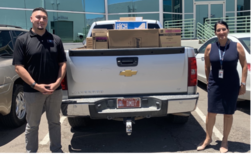
Toy Donation
The Ward 6 office has adopted TPD Community Engagement officer Lt. Margo Susco. This is Margo, standing out in front of the GAP ministries facility with Daniel. He’s one of our community heroes working out at the Alitas Welcome Center. Daniel’s truck is full of new toys – donations from Good360 and Toys for Tots.
GAP received over 12,000 new toys for distribution throughout the region. The overall give-away events will take place during July through 2 TPD drive-up free toy give aways. One will be held on the southside, and one in midtown.
In advance of that, Margo called and offered a pallet of toys for the migrant families. I was happy to accept, and Daniel donated his truck and labor (with his sister) to get the toys delivered to Alitas.
Each week we continue to receive donations from many of you out in the community. In addition to Margo’s donation, Kristen and Ruth – two women who also served over at the Benedictine - stopped in with donations. We appreciate all of them.
Toiletries, sunscreen, hygiene products – and I think we’re good for a while on the toys unless you’ve just got some you need to share. Thank you to each of you for caring. Coordinate deliveries with me directly at steve.kozachik@tucsonaz.gov.
Pulse Anniversary
I’ve still got the Ward 6 flag at half-staff. It has been there for weeks. It seems mass shootings are the way we handle disagreements these days. So there are always lost loved ones to remember.
Saturday was the 5th anniversary of the Pulse nightclub murders. That night, 49 people were killed in an attack that was aimed at the LGBT community. I think it was cool that during the celebration in Orlando on Saturday, this rainbow appeared over the nightclub.
|
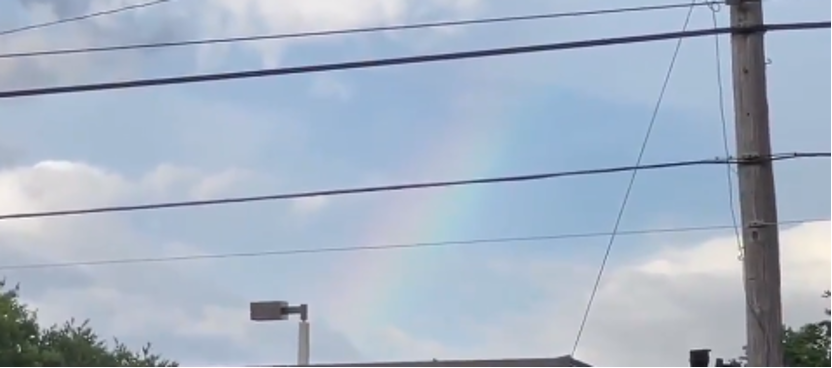 |
The people in attendance suggested the rainbow signaled there were 49 others there as well.
Also, over the weekend, between Savannah, Chicago, and Austin, there were 2 killed and 30 injured in three more shooting incidents. This 2021 summary comes from Gun Violence Archive:
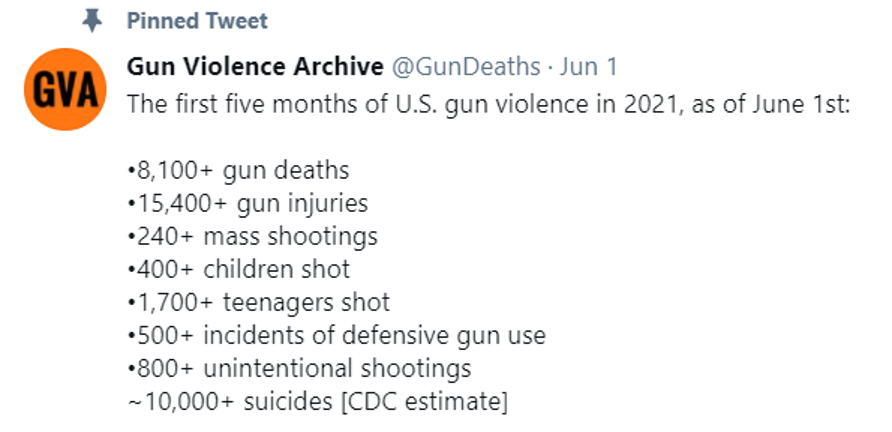
On June 22nd, the city attorney will have for us the Resolution I asked for, letting the state know that in Tucson, we will be recognizing federal gun laws. Clearly, more needs to be done. But eliminating any federally-driven tools we have is not the answer.
PFAS
Last week we announced the shutdown of our TCE and 1, 4 Dioxane treatment plants. Those are called Tucson Airport Remediation Project and Advanced Oxidation Plant. We’ll just use TARP for the newsletter.
The shutdown is because of the significant increase in PFAS contamination just southeast of the facility. The plume is moving towards the plant, and so in a very proactive step, Tucson Water staff recommended the shutdown. Why? So we’re not sending contaminated water to you because water doesn't recognize ward boundaries.
This map shows the significance of the contamination. The blobs on the map are sized to reflect the relative level of contamination. To put into some perspective, we shut down wells if the PFAS level reaches 18 parts per trillion (PPT.) The wells out by TARP are registering above 10,000 PPT in some cases.
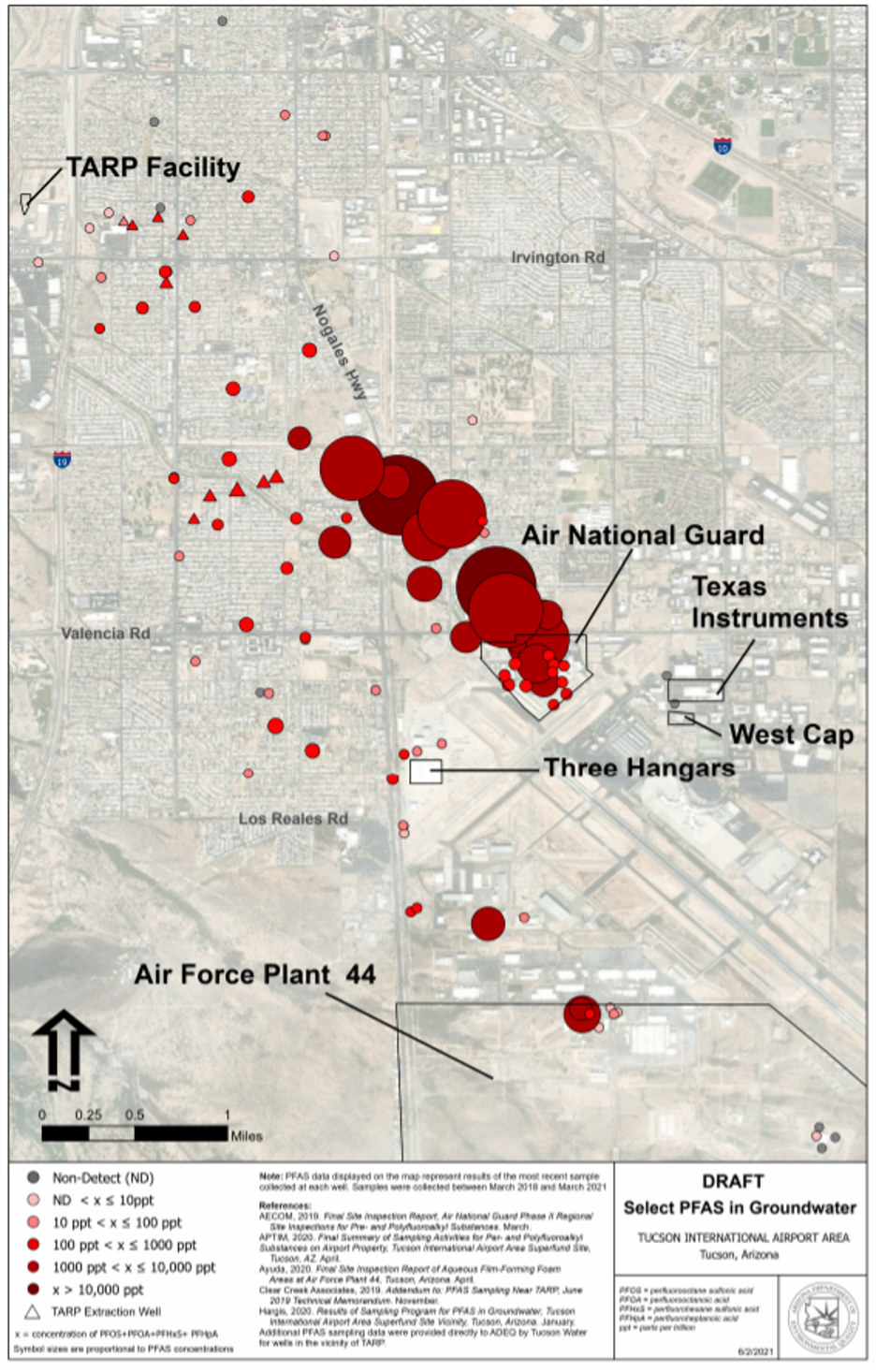
The TARP was designed to clean up TCE and 1, 4 Dioxane. By good fortune, those plants are equipped with carbon filters. Those filters also just happen to capture PFAS. But they’re expensive to change out, and so with the extremely high levels we’re seeing just upstream, the carbon would be overwhelmed by the chemicals, and we’d lose the ability to ensure passing clean water through the plant. The decision to do the shutdown was a prudent management move that is fully supported by the M&C.
Shutting down the plant doesn’t clean up the plume. There is no question the cause is a fire fighting foam used by the Arizona Air National Guard in this location and by the Air Force over by DM. The state is taking the position that the ANG is still a federal responsibility. They’re under the direction of the governor, though. For me, it doesn’t matter who cleans up the mess as long as it’s not paid for by our residents.
The day we shut down the plant, our congressional delegation went into action. Here’s an excerpt from a letter of support written by Representative Grijalva. Clearly, he gets it.

And later in the day, Senator Kelly testified at a Senate Committee hearing, advocating for relief for Tucson. Here’s a 6-minute video clip of his comments. I texted him after watching it, thanking him for his strong support.
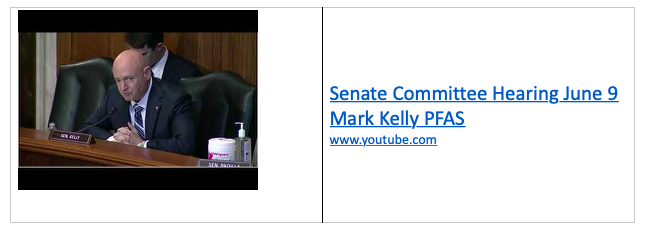
While TARP is shut down, the approximately 60,000 customers it was serving will be receiving a combination of Colorado River water and groundwater from areas other than that region. I’ve written plenty of times that we will need our groundwater at some point. We mostly serve Colorado River (CAP) water now, but as the drought continues, our groundwater becomes more and more a key to life in this area. It cannot be polluted with PFAS.
I write about PFAS pretty regularly. Why? Because water is our lifeblood. Right now, we’re serving over 90% of our customers with CAP water – Colorado River water. That supply is affected by the megadrought we’re experiencing. But to be clear, the drought is half of the equation. The other half is our demand. Each week we continue to see more large housing developments going in up in Pinal County. It’s such short-term thinking. We have overdrafted the Colorado – like overdrafting your checking account. By far, the largest user of our water is the agriculture industry – about 70% among the states reliant on the Colorado. It’s anticipated that within the next year, Arizona will see reductions in deliveries from the CAP due to the drought. As that continues, and as the reductions increase, our reliance on our groundwater increases in importance.
This is a current picture of Lake Mead – our supplier of CAP water. Note the bathtub ring. It’s at 36% capacity – the lowest level in the past 85 years.
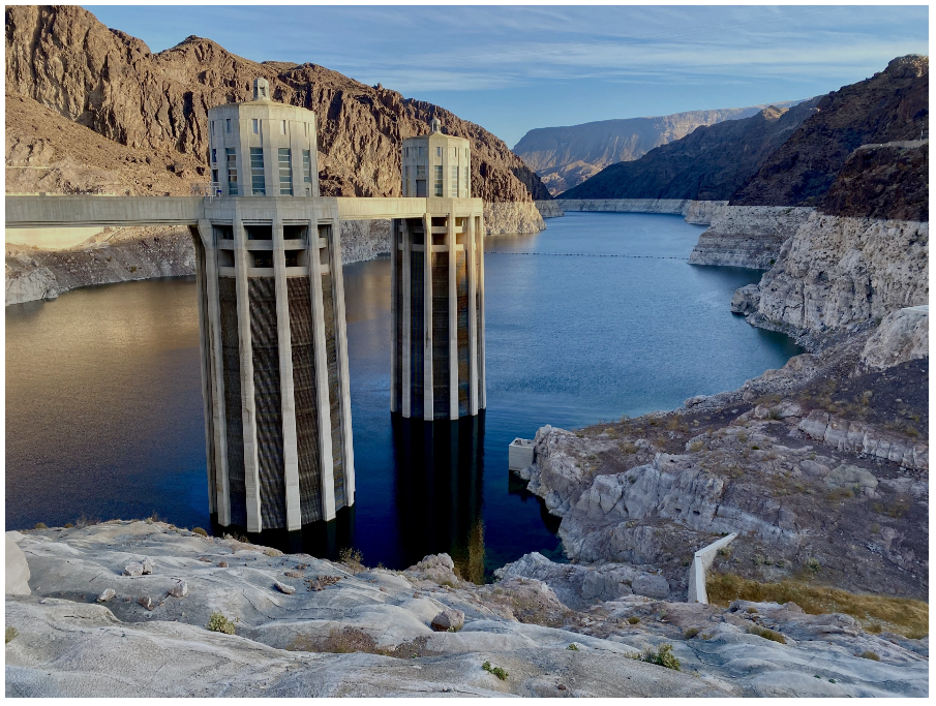
That means the PFAS issue must be addressed.
I’m going to keep this reminder in the newsletter each week leading up to the PFAS presentation I’m hosting later this month. We are not going to be the next Flint, Michigan – and being fully transparent with all of the water-related information I’ve got is one way we will ensure that.
The meeting we’re having on June 30th will focus primarily on the area around DM, just southeast of the central well field. But I suspect some on the call will have questions about this TARP action. It’s all on the table.
As was true last time, we’ll have representatives from the DOD, EPA, ADEQ, Tucson Water and one of our city water attorneys on the call. The meeting will run from 6 pm until 7:30 pm. Here’s the zoom link for you to join:
Meeting ID: 829 6307 3142
Passcode: 129988
5G
We experienced a small bit of progress in one location last week. I shared this picture with you in last week’s newsletter. It’s Fernando and Norte – the wooden stakes are where AT&T originally proposed a cell pole.
After some back and forth, they agreed to move it to the street sign. Neighbors joined forces and met the subcontractors when they arrived to begin work. Long story made short – after a series of exchanges that I had with city staff, AT&T has agreed to delay the start of construction at this site until September. In the interim, we’ll be working with them to find alternatives.
Up the street, at Longfellow and 5th, another group of neighbors has been holding daily bake sales in the Right of Way adjacent to where a Verizon pole was to be erected. We’re in touch with Verizon reps to see if the same solution can be worked out. While there’s no guarantee this will end in the poles being moved or eliminated, it’s a sign the companies hear the community voice asking for more and earlier involvement in the decisions as to where the poles will go.
Soon we’ll have our internal utility infrastructure manual that will also play a role in site decisions and public notice. I’ll share that with you when it’s ready for prime time.
 |
|
On Tuesday, the 15th, Sustainable Tucson is hosting UA Dr. Russell Witte. He will be presenting some research on the health effects of low exposures to 5G technology. The meeting is by Zoom – and you can get the link at www.sustainabletucson.org. The meeting begins at 6 pm and should last until 7:30.
|
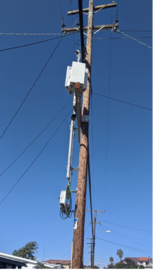
The city is precluded by both FCC rules and by state law from basing our permitting decisions related to 5G on health effects.
I’m still including in all of my outreach to the telecom folks the notion of collocating on TEP poles. This photo shows that doing so does not necessarily require removing the pole. Despite a TEP leader stating that they’ve accommodated one collocation in Tucson since I started pushing them in that direction, that never happened. TEP evidently made the offer, and the telecom provider turned them down. We’ll keep the option in our mix in the new manual.
|
RTA Next
Last week the Star kindly ran a guest piece I wrote about our discussions with the RTA related to taking that transportation plan back to the voters. That plan expires in 2026, so they’re working on what a next round would look like. At the same time, the city is looking at our own transportation and mobility needs. At last week’s M&C meeting, we announced a May 2022 special election for Proposition 101. That's the extension of our current road repair/public safety half-cent tax. Soon you’ll see a survey asking what you’d like to see in a new 101. So all of that’s happening in real-time, simultaneously. And it all has an impact on RTA Next. Here’s the guest piece, with thanks as always to Sarah from the Star.
The 2006, voter-approved Regional Transportation Plan (RTA) is our 20-year regional transportation and mobility policy guide. It’s up for reconsideration in 2026, and like any piece of public policy, there are some “lesson’s learned” that we should not be afraid to address as we approach a reauthorization vote.
The city of Tucson is one of nine members of the RTA Board. Others include the various jurisdictions in the region, Pima County, and the two tribal nations. Together that group meets to discuss and vote on the implementation of the RTA plan. And currently, that group is meeting to discuss possible changes the plan should include before it goes back to the voters.
In a guest opinion piece that Marana Mayor Ed Honea wrote that appeared in the May 28 Arizona Daily Star, he states, “in order for the RTA to be successful, it must be accountable to the voters.” That is absolutely true, and over 40% of the voters who will participate in the reauthorization election live within the Tucson city limits. Without their strong support, any new RTA Plan will fail at the ballot box.
The Tucson mayor and City Council have raised some issues that are of concern to our constituents. One is that currently, our vote on the RTA Board counts the same as every other jurisdiction’s vote. Despite our relatively greater proportionate contribution to the success of the plan, Tucson’s vote counts the same as that of Sahuarita, Oro Valley, and the rest of the member jurisdictions.
Mr. Honea states the equal voting scheme is codified in the statute. That’s true. And it’s also true that the statute he refers to becomes obsolete if the 2026 RTA vote fails. The RTA members can, and must, develop a means of allowing some form of weighted voting, as is done in Maricopa County or Tucson is not fairly representing the interests of our constituents.
Tucson was asked to provide a project list so the RTA Board can evaluate it and decide on which projects will appear on the next ballot. Our list was to be equal in value to those of every other jurisdiction in the region. Mr. Honea states the Tucson list should indeed be subject to what he calls a “regional public process.”
In the alternative, let’s agree that Tucson should have no more voice in what Marana residents feel is important to their transportation needs than Marana residents should have in Tucson identifying our needs. Set a value for projects that reflects the relative tax contribution each jurisdiction provides to the Regional Plan and allow each jurisdiction to present its own list for voter consideration. That ensures we’re all presenting what we’re hearing from our local residents.
Another issue the Tucson City Council and mayor have identified as being necessary for us to support the new RTA Plan is dedicated funding for road repair. That’s completely missing from the current plan. All we’re doing is expanding capacity and not setting aside any money for maintenance.
In addition, we’ve stated the need for flexibility being built into the plan. Nobody can expect transportation needs and preferences to be the same 20 years from now as they are today.
Let’s avoid future Broadway expansion conflicts by including some latitude to respond to changing trends over time. Doing so will also allow us to react to the financial challenges the RTA is facing and will continue to face. Tucson projects are currently underfunded by nearly $300 million. Our Mayor and City Council would be justifiably criticized by our residents if we failed to insist on fair treatment going forward.
The issues we’re insisting be open for discussion do not constitute the city “taking its ball and going home.” They do reflect our relative impact on the funding stream for the RTA, our insistence that our voice on the board respect that impact, and they reflect our expectation that at the sunset of the next RTA, the then Tucson mayor, and City Council will not have to explain to their constituents why their needs were not addressed, even though their tax money funded those of surrounding jurisdictions.
As a region, that is not a conversation we should shy away from.
More Transportation
Our downtown division from TPD has been working with Diana from my office and the leadership from Main Gate, 4th Ave, and downtown to help better manage people getting home after maybe having one-too-many at a local watering hole. We’re grateful to Donovan from Park Tucson and to our Ride Share partners for helping pull this together.
These maps show the location in each of those entertainment districts where you’ll find a ride during the times set aside. Note that these are being set aside during the 5 pm – 3 am window in each location. In addition, to help with some of the behavioral problems we’ve encountered, there will also be an increased police presence. The goal is to help the vast majority of people who simply want a safe and fun night out to get home safely too. Here are the maps: clip and save – and use your rideshare app to direct you to the parking area if you don’t have a copy of the map handy.
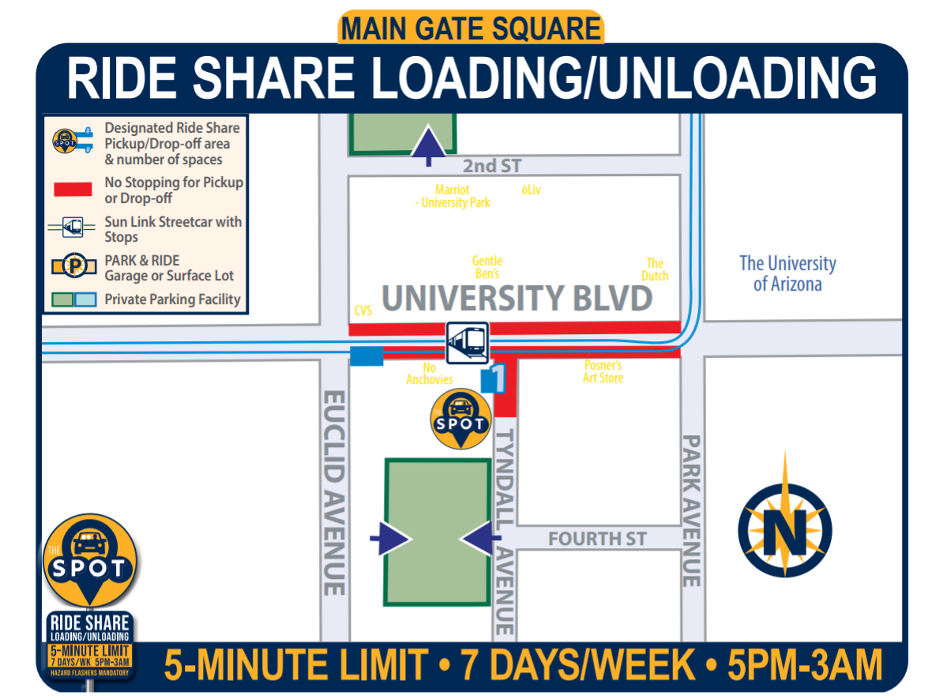 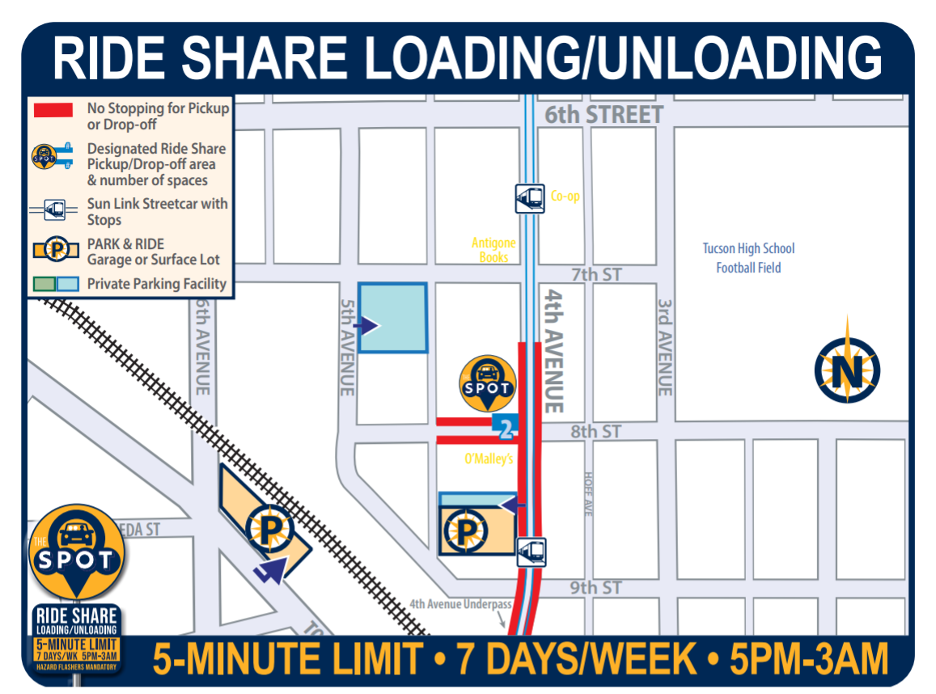 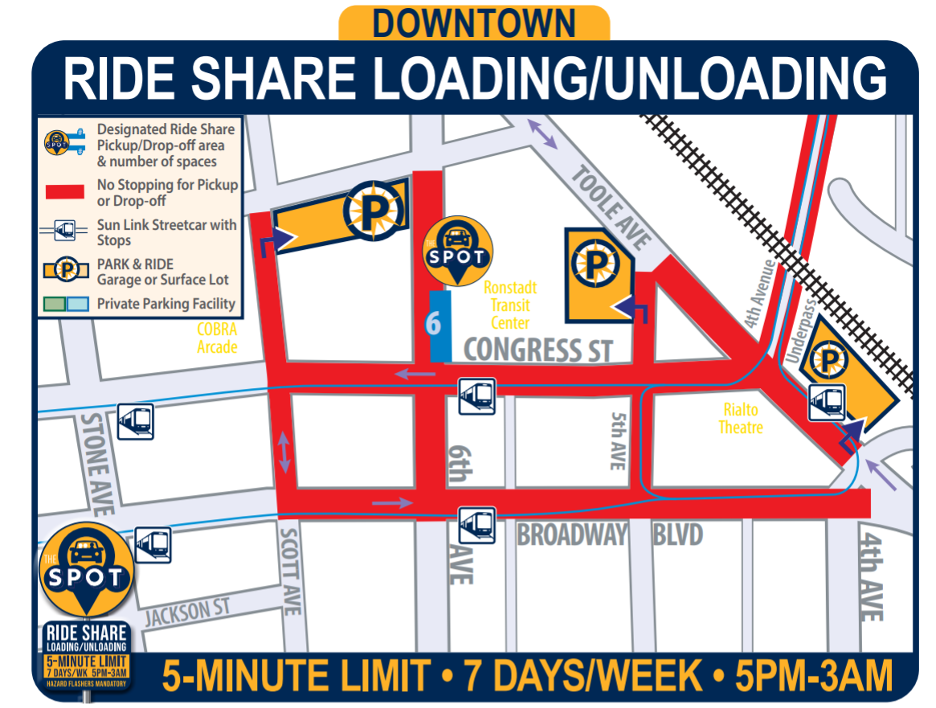
Thanks to all who have taken the time to pull this together. Please drink responsibly – and get home safely.
Name, Image, and Likeness (NIL)
During a candidate forum hosted by the NAACP last week, I mentioned my advocacy for student-athletes in their battle for reaping some of the billions of dollars the NCAA is pulling in from media and game-day revenues. It’s called Name, Image, and Likeness (NIL) inside the departments. It’s a hot item right now because on July 1st, unless Congress adopts an NIL law that impacts all schools the same way, some states will have a pretty significant recruiting advantage.

If you’re a student-athlete in Division I of the NCAA, you cannot go get a job at a fast-food restaurant without violating NCAA rules. And it’d be a hard balance anyway. They compete, go to the training table, attend practices daily, travel to away events – and study. Inside athletics, the argument is they’re getting an education, so that’s fair. The other side of the conversation is the NCAA is a multi-billion dollar industry, and student-athletes are paid nothing when their names, images, or likenesses are used to market the Association.
On July 1st, Alabama, Florida, Georgia, Mississippi, and New Mexico will adopt their own laws allowing student-athletes to take part in NIL deals. If that happens, schools in those 5 states will immediately have a recruiting advantage over all other schools. If you’re a student-athlete and say Alabama offers you the chance to make extra cash when they sell a jersey with your name on it, that’s where you’re going to school. Other states are also considering NIL laws.
The NCAA is lobbying congress for a comprehensive law while at the same time reserving the right to file an injunction trying to stop individual states from passing their own. Richard Blumenthal, a Connecticut senator, said, “The NCAA is at the table only because it’s been hauled kicking and screaming hereafter, dithering and delaying too long. They’re here only because they fear that patchwork – the states are, in effect, running to the top while the NCAA and its rules are racing to the bottom common denominator.” He and Senator Booker from New Jersey have sponsored a comprehensive
On June 23rd, the NCAA Division I Council will meet to talk about NIL. The safe bet is that they’ll wait to see what Congress does. The only clear thing is that on July 1st when those state laws take effect, intercollegiate athletics will enter a new day.
I worked on the inside for 32 years and can say with confidence that it’s a money-driven industry. Yes, student-athletes get an education. And a very few ever move onto making a living in their sport-of-choice after college. In recent months, we’ve seen the UA give over $8M in buyouts to coaches who are on their way out the door and give pay packages of several million dollars to incoming and existing coaches. That buys a lot of burgers at a local fast food.
|

Vaccine Update
There are now 494 colleges and universities throughout the country that have announced they’ll require vaccination before students and staff return to campus in the fall.
|
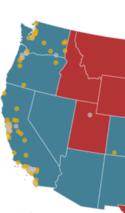
The dots on the map show which schools are on board. Note the UA still has not decided that’d be a good thing for the community. Politics over medicine.
As you’ll see below, our reported case counts are way down. That’s good. Much of that has to be due to the impact of vaccinations. I continue to be concerned with the significant differences in vaccination rates we see internationally. This NY Times graph shows pretty clearly what I mean.
|

In the U.S., the change in hospitalizations has skewed towards younger people who have not been vaccinated. Over 80% of people over age 65 have received at least one dose of a COVID vaccine. Only about a half of people ages 25-64 have – and most of those trend towards the upper range of the age group.
Dr. Krutika Duppalli is an infectious disease expert at the Medical University of South Carolina. Her comment was, “I still think the narrative, unfortunately, is out there with younger people that they can’t suffer the adverse effects related to COVID.” That’s not what’s being seen right now.
Even with our local numbers of new infections going down, this map shows that Arizona is still one of the states in which fatalities are occurring pretty much everywhere in the state.
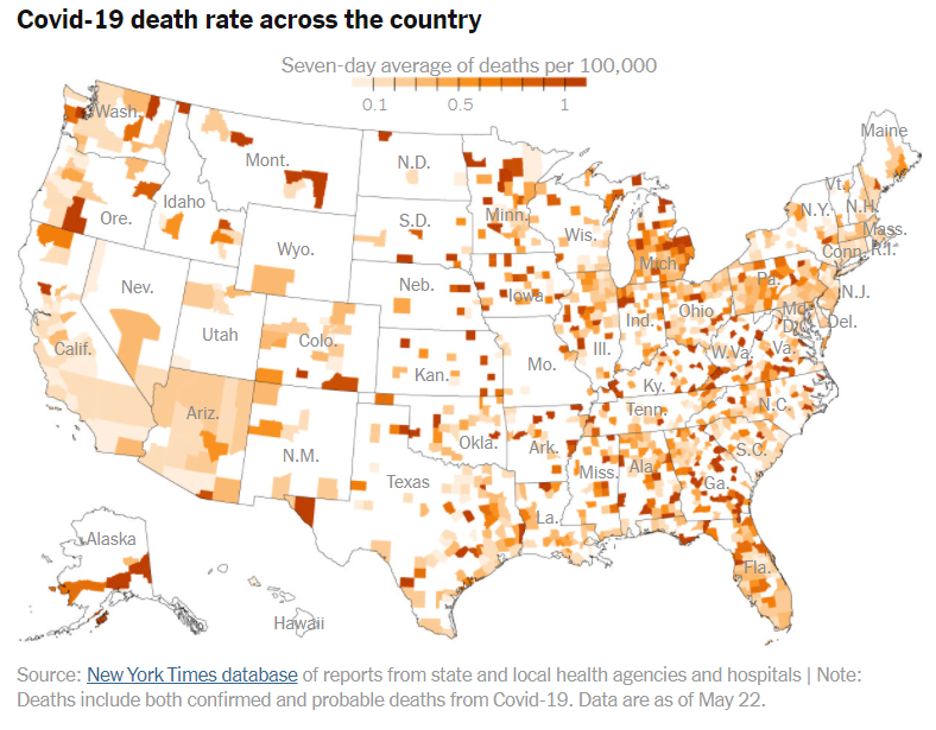
Over the weekend, I saw two articles on the impacts the Delta COVID variant is having in Russia and China. In Russia last Saturday, they had over 13,000 new cases, 6,700 of which were in Moscow. And that variant is hitting China, Britain, and Brazil hard right now. It’s described as being more dangerous, and the symptoms spread in a person much more quickly than COVID-19 did. It speaks to the need for vaccinations. The article I saw said 2/3 of Russians are not getting vaccinated.
We had about 50 people take part in the vaccination event held during Safari Night at the zoo last week. We’ll be doing that again on July 17th. I’ll be doing the music set from 6 pm until 8 pm, so please plan on bringing someone who needs a vaccine to get that done; enjoy the zoo and a little music.
Here are this week’s mobile vaccination sites being run by the Pima County health folks and their partners. No appointment is needed for any of these sites.
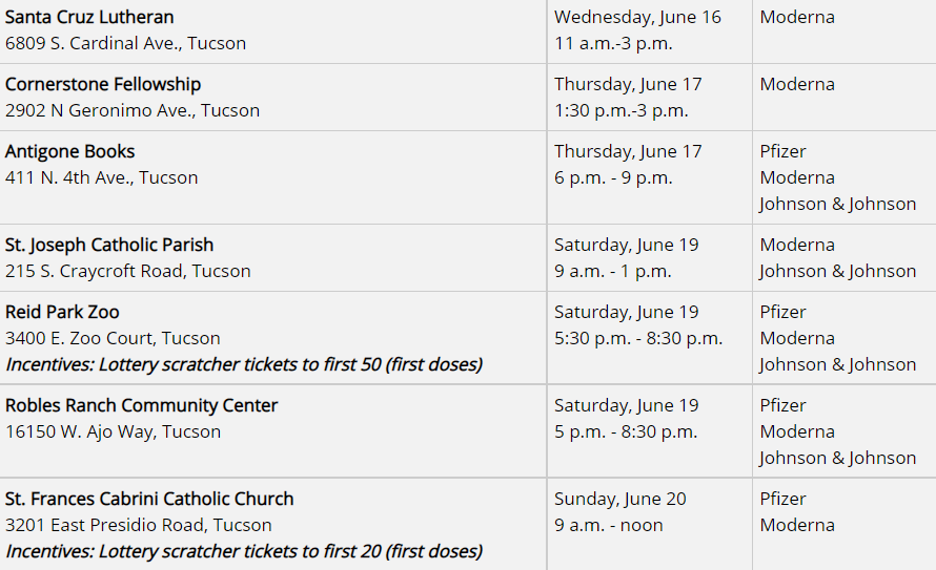
Last week in Pima County, we had 130 new cases reported. A month ago, we were seeing over 400 cases per week, so this is very good news.
Not much change in the ‘spread-rate’ in the state, or the UA area. Pima County did see a slight uptick, though. The most recent data is a week old, but with students now having largely gone home, it’s probably a safe bet to think the data is pretty accurate.
Harvard Global Health Institute
This week’s Harvard Global health risk map is once again a little less guarded than it was last week. Arizona is finally now all in yellow. That’s a relatively low risk, but relative to where we were. Our daily numbers of new infections still reflect COVID in the community. And look at Florida. Not too long ago, they were one of the more heavily impacted states in the country. They’re enjoying all green now. The vaccinations are clearly helping. The variants remain a concern. So please get vaccinated to help us all get back out and into wider circulation once again.

Internationally the infections have moved most significantly into Central and South America. India is also still a tragic situation. This hot spot map makes that clear.
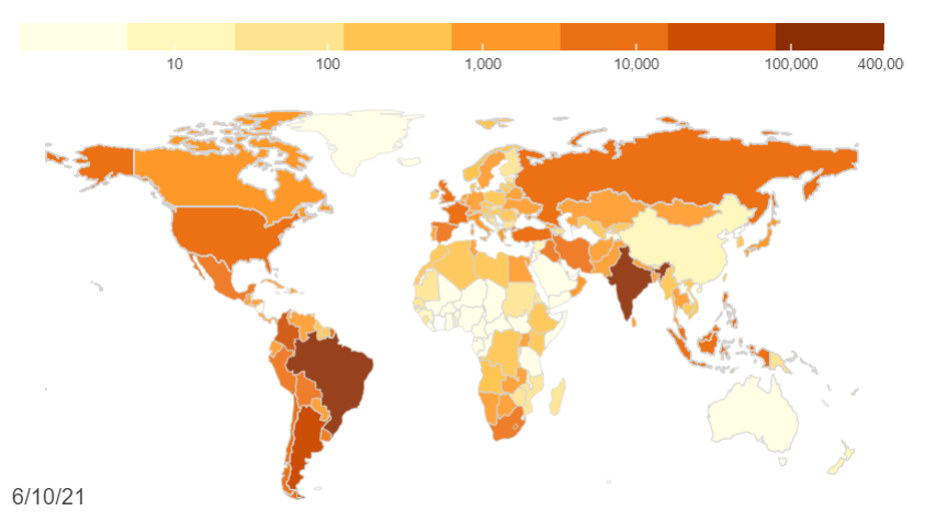
It’s starting to pick up a bit on the African sub-continent, but I’d be willing to bet it’s worse there than we know since testing and reporting is nothing near what we’re accustomed to in other parts of the world. Again - the message – get vaccinated.
Here’s our statewide map. These are cumulative numbers. As noted above, they’re slowing down significantly.
Sincerely,

Steve Kozachik
Council Member, Ward 6
ward6@tucsonaz.gov

City of Tucson Resources
|